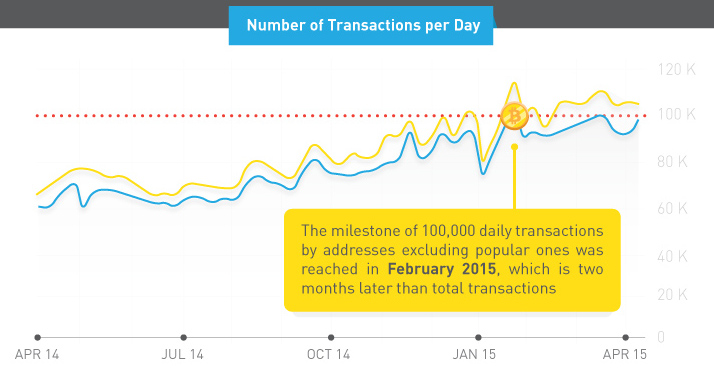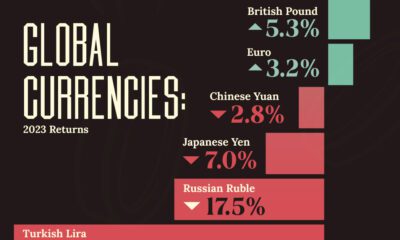Technology
Bitcoin is Finally Becoming an “Everyday Use” Currency

Bitcoin is Finally Becoming an “Everyday Use” Currency
Over the last few years, Bitcoin has gained a reputation as an investment commodity. It has been toted as a method to preserve wealth and to hedge against currency devaluation as bitcoins cannot be “printed”.
This reputation still holds true today. With Greece’s economy on the rocks and the unfolding aftermath of a “no” decision, the bitcoin price has skyrocketed by around 20% in the last month. While Greeks are having difficulties buying the cryptocurrency due to capital controls, Coinbase has reported that buys across Europe have increased 300% as others observe what is happening in Greece.
However, recent transaction data also shows that more bitcoins are being spent on “everyday use” items. Bitpay, which facilitates retail transactions using bitcoins, reports that the number of transactions has increased from 209,420 to 563,568 (from 2013 to 2014). Interestingly, the average order amount decreased substantially from $513 to $281 per order as more people bought more everyday items.
What are people buying with bitcoins? It turns out the list is pretty boring: bedroom sheets, headphones, area rugs, mattresses, coffee tables, sunglasses, and donations to non-profits all help round out the top ten items bought on Overstock.com. With the cryptocurrency becoming more ubiquitous as shown by reaching the 100k daily transaction mark (not including popular addresses) this year, it is being used more and more for regular ecommerce purchases.
As we’ve previously shown with technology hype cycles, it takes some time for new innovations to develop the infrastructure to reach their hyped potential. There is evidence that shows that cryptocurrencies and Bitcoin are along this path. Even though they are primed to change the world and spur even more innovation, the world has not yet been ready. It seems to be getting closer, though.
Original graphic by: Coupofy
Technology
Visualizing AI Patents by Country
See which countries have been granted the most AI patents each year, from 2012 to 2022.

Visualizing AI Patents by Country
This was originally posted on our Voronoi app. Download the app for free on iOS or Android and discover incredible data-driven charts from a variety of trusted sources.
This infographic shows the number of AI-related patents granted each year from 2010 to 2022 (latest data available). These figures come from the Center for Security and Emerging Technology (CSET), accessed via Stanford University’s 2024 AI Index Report.
From this data, we can see that China first overtook the U.S. in 2013. Since then, the country has seen enormous growth in the number of AI patents granted each year.
| Year | China | EU and UK | U.S. | RoW | Global Total |
|---|---|---|---|---|---|
| 2010 | 307 | 137 | 984 | 571 | 1,999 |
| 2011 | 516 | 129 | 980 | 581 | 2,206 |
| 2012 | 926 | 112 | 950 | 660 | 2,648 |
| 2013 | 1,035 | 91 | 970 | 627 | 2,723 |
| 2014 | 1,278 | 97 | 1,078 | 667 | 3,120 |
| 2015 | 1,721 | 110 | 1,135 | 539 | 3,505 |
| 2016 | 1,621 | 128 | 1,298 | 714 | 3,761 |
| 2017 | 2,428 | 144 | 1,489 | 1,075 | 5,136 |
| 2018 | 4,741 | 155 | 1,674 | 1,574 | 8,144 |
| 2019 | 9,530 | 322 | 3,211 | 2,720 | 15,783 |
| 2020 | 13,071 | 406 | 5,441 | 4,455 | 23,373 |
| 2021 | 21,907 | 623 | 8,219 | 7,519 | 38,268 |
| 2022 | 35,315 | 1,173 | 12,077 | 13,699 | 62,264 |
In 2022, China was granted more patents than every other country combined.
While this suggests that the country is very active in researching the field of artificial intelligence, it doesn’t necessarily mean that China is the farthest in terms of capability.
Key Facts About AI Patents
According to CSET, AI patents relate to mathematical relationships and algorithms, which are considered abstract ideas under patent law. They can also have different meaning, depending on where they are filed.
In the U.S., AI patenting is concentrated amongst large companies including IBM, Microsoft, and Google. On the other hand, AI patenting in China is more distributed across government organizations, universities, and tech firms (e.g. Tencent).
In terms of focus area, China’s patents are typically related to computer vision, a field of AI that enables computers and systems to interpret visual data and inputs. Meanwhile America’s efforts are more evenly distributed across research fields.
Learn More About AI From Visual Capitalist
If you want to see more data visualizations on artificial intelligence, check out this graphic that shows which job departments will be impacted by AI the most.
-

 Markets1 week ago
Markets1 week agoU.S. Debt Interest Payments Reach $1 Trillion
-

 Markets2 weeks ago
Markets2 weeks agoRanked: The Most Valuable Housing Markets in America
-

 Money2 weeks ago
Money2 weeks agoWhich States Have the Highest Minimum Wage in America?
-

 AI2 weeks ago
AI2 weeks agoRanked: Semiconductor Companies by Industry Revenue Share
-

 Markets2 weeks ago
Markets2 weeks agoRanked: The World’s Top Flight Routes, by Revenue
-

 Countries2 weeks ago
Countries2 weeks agoPopulation Projections: The World’s 6 Largest Countries in 2075
-

 Markets2 weeks ago
Markets2 weeks agoThe Top 10 States by Real GDP Growth in 2023
-

 Money2 weeks ago
Money2 weeks agoThe Smallest Gender Wage Gaps in OECD Countries















